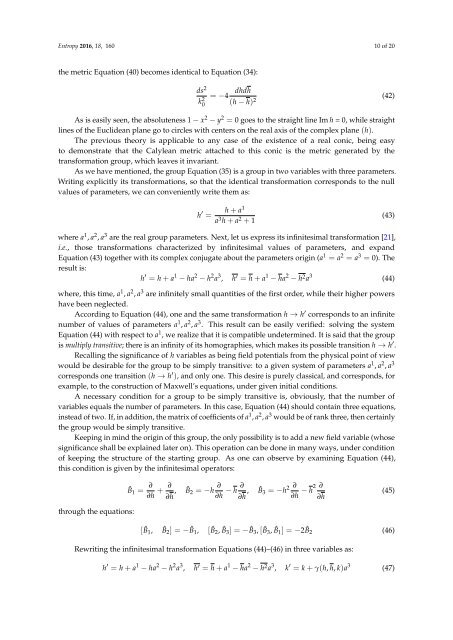entropy-18-00160
You also want an ePaper? Increase the reach of your titles
YUMPU automatically turns print PDFs into web optimized ePapers that Google loves.
Entropy 2016, <strong>18</strong>, 160 10 of 20<br />
the metric Equation (40) becomes identical to Equation (34):<br />
ds 2<br />
k 2 0<br />
= −4 dhdh<br />
(h − h) 2 (42)<br />
As is easily seen, the absoluteness 1 − x 2 − y 2 = 0 goes to the straight line Im h = 0, while straight<br />
lines of the Euclidean plane go to circles with centers on the real axis of the complex plane (h).<br />
The previous theory is applicable to any case of the existence of a real conic, being easy<br />
to demonstrate that the Calylean metric attached to this conic is the metric generated by the<br />
transformation group, which leaves it invariant.<br />
As we have mentioned, the group Equation (35) is a group in two variables with three parameters.<br />
Writing explicitly its transformations, so that the identical transformation corresponds to the null<br />
values of parameters, we can conveniently write them as:<br />
h ′ =<br />
h + a 1<br />
a 3 h + a 2 + 1<br />
(43)<br />
where a 1 , a 2 , a 3 are the real group parameters. Next, let us express its infinitesimal transformation [21],<br />
i.e., those transformations characterized by infinitesimal values of parameters, and expand<br />
Equation (43) together with its complex conjugate about the parameters origin (a 1 = a 2 = a 3 = 0). The<br />
result is:<br />
h ′ = h + a 1 − ha 2 − h 2 a 3 , h ′ = h + a 1 − ha 2 − h 2 a 3 (44)<br />
where, this time, a 1 , a 2 , a 3 are infinitely small quantities of the first order, while their higher powers<br />
have been neglected.<br />
According to Equation (44), one and the same transformation h → h ′ corresponds to an infinite<br />
number of values of parameters a 1 , a 2 , a 3 . This result can be easily verified: solving the system<br />
Equation (44) with respect to a 1 , we realize that it is compatible undetermined. It is said that the group<br />
is multiply transitive; there is an infinity of its homographies, which makes its possible transition h → h ′ .<br />
Recalling the significance of h variables as being field potentials from the physical point of view<br />
would be desirable for the group to be simply transitive: to a given system of parameters a 1 , a 2 , a 3<br />
corresponds one transition (h → h ′ ), and only one. This desire is purely classical, and corresponds, for<br />
example, to the construction of Maxwell’s equations, under given initial conditions.<br />
A necessary condition for a group to be simply transitive is, obviously, that the number of<br />
variables equals the number of parameters. In this case, Equation (44) should contain three equations,<br />
instead of two. If, in addition, the matrix of coefficients of a 1 , a 2 , a 3 would be of rank three, then certainly<br />
the group would be simply transitive.<br />
Keeping in mind the origin of this group, the only possibility is to add a new field variable (whose<br />
significance shall be explained later on). This operation can be done in many ways, under condition<br />
of keeping the structure of the starting group. As one can observe by examining Equation (44),<br />
this condition is given by the infinitesimal operators:<br />
ˆB 1 = ∂<br />
∂h + ∂<br />
∂h ,<br />
ˆB 2 = −h ∂<br />
∂h − h ∂<br />
∂h ,<br />
ˆB 3 = −h 2 ∂<br />
∂h − h2 ∂<br />
∂h<br />
(45)<br />
through the equations:<br />
[ ˆB 1 , ˆB 2 ] = − ˆB 1 , [ ˆB 2 , ˆB 3 ] = − ˆB 3 , [ ˆB 3 , ˆB 1 ] = −2 ˆB 2 (46)<br />
Rewriting the infinitesimal transformation Equations (44)–(46) in three variables as:<br />
h ′ = h + a 1 − ha 2 − h 2 a 3 , h ′ = h + a 1 − ha 2 − h 2 a 3 , k ′ = k + γ(h, h, k)a 3 (47)



